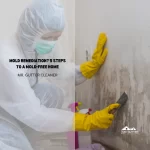Understanding the causes of mold in a house is crucial for effective home maintenance. Mold thrives in damp, poorly ventilated environments, directly linking its growth to excessive moisture.
This moisture can originate from various sources, including leaking pipes, roof leaks, and condensation, particularly in areas like basements, bathrooms, and kitchens where water usage is high.
Effective prevention strategies involve managing humidity levels within the home, ensuring adequate ventilation, and promptly addressing water leaks.
For homeowners, recognizing the signs of mold—visible growths or musty odors—is the first step toward mitigation.
Taking proactive measures, such as using dehumidifiers and maintaining regular home inspections, can significantly reduce the risk of mold.
Promptly addressing mold preserves both home integrity and inhabitants’ health, emphasizing the need for understanding causes and preventive measures in home maintenance.
Regular cleaning and maintenance routines, coupled with swift remediation actions upon mold detection, are essential components of a holistic approach to safeguarding both property and occupants from the harmful effects of mold infestations.
Why Is Mold a Concern for Homeowners?
Mold poses serious risks, impacting health and home integrity. Its presence can lead to respiratory issues, allergic reactions, and even structural damage to properties. Understanding and addressing the causes of mold is crucial for maintaining a safe and healthy living environment.
How Does Mold Impact Health?
Exposure to mold can cause symptoms such as coughing, sneezing, throat irritation, and in severe cases, asthmatic episodes. Individuals with compromised immune systems or pre-existing respiratory conditions are particularly at risk.
Table of Contents:
- Why Is Mold a Concern for Homeowners?
- What Conditions Allow Mold to Grow?
- Where Is Mold Most Likely to Appear in Your Home?
- What Are the Main Sources of Moisture that Lead to Mold?
- How Can Homeowners Identify Mold in Their House?
- How Can You Prevent Mold Growth in Your Home?
- What Should You Do If You Find Mold in Your Home?
- FAQs on Mold Prevention and Remediation
What Are the Structural Risks Posed by Mold?
Beyond health concerns, mold can weaken building materials, leading to costly repairs. It deteriorates wood, drywall, and other materials, compromising the structural integrity of homes. Identifying and eliminating sources of moisture is essential in preventing mold growth and preserving the condition of a property.
What Conditions Allow Mold to Grow?
Mold growth in homes requires three primary conditions: moisture, suitable temperatures, and organic materials to feed on. The absence of these conditions significantly reduces the risk of mold development.
What Role Does Humidity Play in Mold Growth?
Humidity levels play a crucial role in mold growth. Mold thrives in environments with high humidity levels, typically above 60%. Controlling indoor humidity levels, therefore, is essential in preventing mold proliferation.
How Does Temperature Influence Mold Proliferation?
Temperature also significantly influences mold growth. Mold prefers warm temperatures, usually between 77°F and 86°F. However, it can still grow at temperatures outside this range if other conditions are favorable.
Why Is Adequate Ventilation Crucial for Preventing Mold?
Proper ventilation helps reduce moisture and humidity levels in the home, making it less hospitable for mold. Ensuring that areas prone to moisture, such as kitchens and bathrooms, are well-ventilated can prevent mold from finding the conditions it needs to grow.
Where Is Mold Most Likely to Appear in Your Home?
Mold commonly appears in areas of a home where excess moisture can accumulate. Understanding these prone areas can help homeowners take proactive measures to mitigate mold growth.
Why Are Basements Prone to Mold?
Basements are particularly susceptible to mold due to their below-ground location, making them prone to dampness and poor ventilation. These conditions provide an ideal breeding ground for mold.
What Makes Bathrooms Common Areas for Mold?
Bathrooms consistently have high humidity levels from showers, baths, and sinks, combined with limited airflow, making them a common site for mold development.
How Can Kitchens Harbor Mold?
Kitchens can harbor mold due to moisture from cooking, washing dishes, and using appliances like refrigerators and dishwashers. Leaks under sinks and around appliances also contribute to mold growth.
What Are the Main Sources of Moisture that Lead to Mold?
Identifying the primary sources of moisture in homes is critical for mold prevention. Moisture is the lifeblood of mold, and without it, mold cannot grow.
How Do Leaking Pipes Contribute to Mold Growth?
Leaking pipes are a significant source of moisture, often hidden within walls and under floors, making them hard to detect until mold has begun to spread. Regular inspections of plumbing systems can prevent such leaks from going unnoticed.
What Is the Connection Between Roof Leaks and Mold?
Roof leaks introduce moisture into attic spaces and ceiling cavities, creating an ideal environment for mold. Homeowners should inspect their roofs regularly, especially after severe weather, to ensure any damage is promptly repaired.
Can Condensation Lead to Mold Problems?
Condensation, particularly on windows and in poorly ventilated areas, can accumulate and provide enough moisture for mold growth. Improving ventilation and insulation in these areas can significantly reduce condensation.
How Can Homeowners Identify Mold in Their House?
Identifying mold early is crucial in preventing its spread and mitigating potential health risks and structural damage. Homeowners can use several methods to detect mold presence in their homes.
What Are the Visible Signs of Mold?
Visible signs of mold include black, green, or white spots on surfaces, especially in damp areas. Mold often appears as a fuzzy or slimy layer, indicating a significant growth area that requires immediate attention.
Are There Smell Indicators of Mold Presence?
A musty, earthy smell is a strong indicator of mold presence, even if it’s not visibly apparent. This odor is particularly noticeable in poorly ventilated spaces where mold thrives due to moisture accumulation.
What Are Professional Methods for Detecting Mold?
Professional mold detection involves using moisture meters, infrared cameras, and air sampling tests to identify mold spores in the air and hidden mold growth within walls or under floors. Hiring a professional for a comprehensive mold assessment is recommended when homeowners suspect mold but cannot find visible signs or when dealing with recurrent mold issues.
How Can You Prevent Mold Growth in Your Home?
Preventing mold growth is essential for maintaining a healthy home environment. Homeowners can adopt several strategies to minimize the risk of mold development effectively.
Why Is Controlling Humidity Levels Important?
Maintaining indoor humidity levels below 60% is crucial in preventing mold growth.
High humidity provides the perfect conditions for mold spores to thrive.
Using dehumidifiers and air conditioners can help control these levels, especially during humid months.
How Effective Are Dehumidifiers in Preventing Mold?
Dehumidifiers are highly effective in reducing moisture in the air, making environments less hospitable for mold.
Placing dehumidifiers in areas prone to high humidity, such as basements and bathrooms, can significantly mitigate mold risk.
What Are the Benefits of Regular Home Maintenance?
Regular home maintenance, including checking for leaks, ensuring proper ventilation, and cleaning gutters to prevent water buildup, plays a vital role in mold prevention. Addressing minor issues promptly can prevent the conditions that allow mold to flourish.
What Should You Do If You Find Mold in Your Home?
Discovering mold in your home requires immediate action to mitigate health risks and prevent further spread. Here are steps to effectively address mold issues.
When Is It Safe to Remove Mold Yourself?
Mold removal can be a DIY task if the affected area is less than 10 square feet. For small areas, use a solution of water and detergent, but avoid using bleach which can pose its own health risks. Ensure the room is well-ventilated during the cleanup.
When Should You Call a Professional for Mold Removal?
For extensive mold infestation or if mold is found in HVAC systems, it’s crucial to hire professionals. Mold remediation experts have the tools and knowledge to safely remove mold and prevent its recurrence.
How to Choose a Mold Remediation Service?
Select a certified mold remediation service with a proven track record. Look for testimonials and reviews, verify their insurance and certifications, and ensure they provide a detailed plan and estimate before starting the work.
FAQs on Mold Prevention and Remediation
This section addresses common questions homeowners may have about preventing and dealing with mold in their homes, based on the overarching theme of home maintenance and the central search intent to understand mold causes and solutions.
Can Mold Return After Removal?
Yes, mold can return after removal if the underlying moisture problem is not resolved. Ensuring proper ventilation, fixing leaks, and controlling humidity are crucial steps to prevent mold from reoccurring.
How Often Should You Inspect Your Home for Mold?
It’s advisable to inspect your home for mold annually or more frequently if you live in a high-humidity area or have experienced moisture problems in the past. Pay special attention to areas prone to moisture, such as basements, bathrooms, and around windows.
What Are Some Natural Remedies for Mold Prevention?
Natural remedies for mold prevention include improving air circulation with fans and open windows, using dehumidifiers, and applying solutions like vinegar, tea tree oil, or baking soda to discourage mold growth. However, these remedies should complement, not replace, comprehensive moisture control and cleaning practices.


